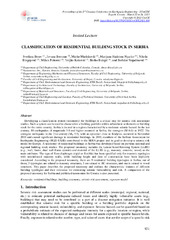Приказ основних података о документу
Classification of residential building stock in Serbia
| dc.creator | Brzev, Svetlana | |
| dc.creator | Borozan, Jovana | |
| dc.creator | Marinković, Marko | |
| dc.creator | Hadzima-Nyarko, Marijana | |
| dc.creator | Blagojević, Nikola | |
| dc.creator | Petrović, Milica | |
| dc.creator | Koković, Veljko | |
| dc.creator | Stojadinović, Božidar | |
| dc.date.accessioned | 2023-10-06T07:18:15Z | |
| dc.date.available | 2023-10-06T07:18:15Z | |
| dc.date.issued | 2023 | |
| dc.identifier.uri | https://grafar.grf.bg.ac.rs/handle/123456789/3196 | |
| dc.description.abstract | Developing a classification system (taxonomy) for buildings is a critical step for seismic risk assessment studies. Such a system can be used to characterize a building portfolio within urban/rural settlements or building stock for the entire country. Serbia is located in a region characterized by a moderate seismic hazard. In the last century, 10 earthquakes of magnitude 5.0 and higher occurred in Serbia, the strongest (M 6.0) in 1922. The strongest earthquake in the 21st century (Mw 5.5), with an epicenter close to Kraljevo, occurred in November 2010 and caused significant damage to residential buildings. In 2019, members of the Serbian Association for Earthquake Engineering (SUZI-SAEE) contributed to the SERA project and its goal to develop a seismic risk model for Europe. A taxonomy of residential buildings in Serbia was developed based on previous national and regional building stock studies. The proposed taxonomy includes the Lateral Load-Resisting System (LLRS) (e.g., wall, frame, dual wall-frame system) and material of the LLRS (e.g., masonry, concrete, wood) as the main attributes. The type of floor diaphragm (rigid or flexible) has been specified only for masonry typologies with unreinforced masonry walls, while building height and date of construction have been implicitly considered. According to the proposed taxonomy, there are 9 residential building typologies in Serbia; out of those, 5 typologies are related to masonry structures, 3 are related to RC structures, and one is related to wood structures. This paper describes the proposed taxonomy and outlines the characteristic features of different building typologies and their relevance for estimating seismic vulnerability and risk. A comparison of the proposed taxonomy for Serbia and published taxonomies for Croatia is also presented. | sr |
| dc.language.iso | en | sr |
| dc.rights | openAccess | sr |
| dc.rights.uri | https://creativecommons.org/licenses/by-nc-nd/4.0/ | |
| dc.source | Proceedings of the 2nd Croatian Conference on Earthquake Engineering - 2CroCEE Zagreb, Croatia - March 22 to 24, 2023 | sr |
| dc.subject | residential buildings | sr |
| dc.subject | building taxonomy | sr |
| dc.subject | seismic risk assessment | sr |
| dc.subject | exposure model | sr |
| dc.title | Classification of residential building stock in Serbia | sr |
| dc.type | conferenceObject | sr |
| dc.rights.license | BY-NC-ND | sr |
| dc.identifier.doi | 10.5592/CO/2CroCEE.2023.100 | |
| dc.identifier.fulltext | http://grafar.grf.bg.ac.rs/bitstream/id/12072/bitstream_12072.pdf | |
| dc.type.version | publishedVersion | sr |

